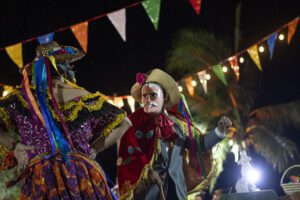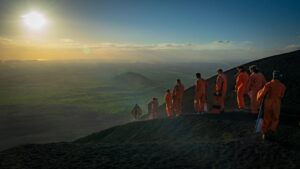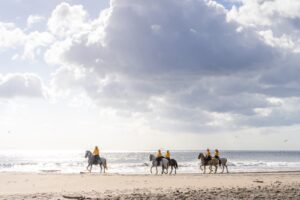By the National Geographic.
A rising number of travelers are discovering this Central American country’s year-round surfing, quaint villages, and new hotels.

Nicaragua may not be at the top of some travelers’ must-visit lists. It surely wasn’t for the husband of Denver-based executive Betsy O’Rourke when she suggested a family vacation there back in 2015. However, she and her surfing-crazed kids won him over.
Post-COVID, the O’Rourkes made a trip back to Nicaragua’s Pacific Coast. For the past two years, they’ve spent January and February in Popoyo, a beach town located about a two-hour drive south of Managua.
The country’s natural beauty, easy-going vibe, and affordability keep drawing them back. “Nicaragua has great beaches. Granada is a beautiful colonial city,” O’Rourke says. And there’s Ometepe, an island formed of two volcanoes in the middle of Central America’s largest lake.
A steady increase in tourism indicates others feel the same way. After the Nicaraguan government loosened pandemic protocols in 2022, major airlines resumed flights to Managua. Shuttered hotels have reopened. The few properties that continued operating throughout the pandemic, including beachfront Rancho Santana and Morgan’s Rock, report that visitors have more than doubled in the past year.
(Related: What are the top five adventures in Nicaragua?)
According to the country’s tourism agency, just over one million visitors arrived in 2023, which is about 84 percent of pre-pandemic levels. The government announced a new highway along the southern Pacific Coast that extends to the Costa Rican border. Also, reconstruction and expansion plans to Punta Huete International Airport, located north of Managua, are underway to help lure Asian tourists and airlines.
Today, visitors in Nicaragua will find oxcarts lumbering along roadways, and uncluttered beaches dotted with small surfing lodges. Colonial cities like Granada and Leon are freshly spruced with welcoming restaurants. Hikers tackle trails bordering Lake Nicaragua. Howler and spider monkeys and fan-tailed motmots gambol in the jungle trees; and roseate spoonbills stroll the beaches.
If you’re considering a trip to Nicaragua, here’s what you should know about visiting the largest of Central America’s republics.

Nicaragua’s bumpy history
In the early 1500s, Nicaragua was colonized by the Spanish, who brought diseases that wiped out about half the indigenous population. The Spanish ruled until 1821, which was the same time the country declared its independence. However, the British still claimed a portion of the Mosquito Coast along the Caribbean. In 1838, Nicaragua became an independent republic after briefly joining a federation of Central American countries.
In the 1930s, the Somoza family came to power, supported by the United States, which always had keen interest in the country’s strategic location. After Daniel Ortega’s Sandanista National Liberation Front overthrew the Somozas in 1979, the U.S. supported rebel Contra forces. These guerrilla tactics helped spur Ortega’s ouster, the National Opposition Union candidate Violeta Chamorro, in the 1990 presidential election.
In 2006, Ortega was reelected. He continues to govern the country despite opposition from the U.S. and human rights advocates because of his authoritarian actions that include closing thousands of non-governmental organizations, quashing opposition, and blocking journalists, according to Human Rights Watch’s 2023 Report. After deadly protests in 2018, when the government sought to increase taxes and cut benefits, Ortega outlawed protests. Today, the country is stable, even if undemocratic.

Top things to do in Nicaragua
With the protests and pandemic fading into memory, tourists are returning, despite U.S. government warnings. Here’s why:
Colonial heritage: Spain’s colonial presence can be seen throughout the country in the central plazas, colorful shop fronts, and grand churches of historic towns like Rivas, Ciudad Antigua, and San Rafael del Norte. The big draw for visitors is the larger rival cities of Granada and Leon with their soaring churches, grand architecture, and a wide array of casual cafes and restaurants. With a population of more than 200,000, Leon ranks as Nicaragua’s intellectual heart and its second largest city after Managua. Granada, an UNESCO World Heritage site, tops most travel itineraries, because of its picturesque location on Lake Nicaragua––the largest lake in Central America.
Wildlife and scenery: Like Costa Rica to the south, Nicaragua is home to more than 700 tropical bird species including kingfishers, trogons, and the colorful motmots. Wildlife includes crocodiles and caimans, a variety of monkeys, and hard-to-spot cats including ocelots and jaguars. Visitors can see the country’s wildlife amid hills plunging to the sea, rock-rimmed coastal coves, jungles, volcanoes and more than 300 jungle-covered islets of Lake Nicaragua.
Ometepe: Twin volcanoes punctuate the sky above Lake Nicaragua. The two––one active, one dormant––are joined by a narrow strip of land, forming the 100-square-mile island of Ometepe. Petroglyphs and archeological sites dot the island; Indigenous peoples consider this place sacred. These distinct features plus waterfalls, beaches, and hot springs have made this UNESCO biosphere reserve a hit with cultural connoisseurs and eco-tourists.
Surfing and beaches: San Juan del Sur on the Pacific Coast is considered Nicaragua’s surf capital because of its central location amid Nicaragua’s best surf breaks, where waves reach 20-feet high or more in the summer. The beach and coves at Popoyo may be slightly less epic but they hit the sweet spot for casual surfers like the O’Rourkes, who find consistent waves throughout the year. Named for the local people, not the pesky insect, the Mosquito Coast on the Caribbean is less accessible, but Nicaragua’s Corn Islands, off the coast of the town of Bluefields, are popular for beaches and small swells.
Affordable, casual vibe: Thanks to its controversial reputation, Nicaragua is still largely overlooked, which means few crowds. While the breezy cafes of Granada and Popoyo are popular among foreigners, neighboring tables are more likely filled with friendly locals. And compared with Costa Rica and the U.S., Nicaragua is a bargain. A beachfront room goes for $50 to $100 a night, and dinner for two in a local restaurant costs under $25.
(Related: Do you enjoy surfing? Add these surf towns to your bucket list.)

My personal experience
After hearing positive reports from recent visitors, I arranged my own reality check following a Costa Rica trip. Dropping our rental car just south of the border, my husband and I walked a few hundred feet to Nicaragua. The crossing is more confusing than most because of its poor signage and a gaggle of vendors. A tourist-friendly crossing is set to open by 2026.
Mindful of those travel warnings, we pre-arranged drivers to take us north to Rancho Santana, near Popoyo, and on to Jicaro Island, in Lake Nicaragua near Granada, and eventually to the airport in Managua. It’s a good move, though not because of safety. Speeding is taken seriously and police hand out tickets liberally. The main roads are surprisingly smooth and well-maintained – better than in Costa Rica.
We made a pitstop in Rivas, the region’s capital, to check out the towering 18th century Catholic church and town square dominated by a massive vase sculpture adorned with a jaguar. It’s a tribute to the indigenous Nahua people. Uncertain about safety, we wandered timidly and were apparently the only tourists in sight on a sleepy Monday morning. A cafe owner welcomed us and seemed happy to chat even though we only buy ice cream. We started to relax.
It’s an easy friendliness that we encountered time and again at hotels, in local restaurants, and in the manicured gardens of Granada. “There’s a natural warm hospitality here. It makes us distinct from an overly curated experience,” says Luke Maish, a 10-year resident and CEO of Rancho Santana.
As visitors, we’re shielded from politics and government repression, and we were free to enjoy Nicaragua’s bright sides.
“There’s a significant difference between what people think about Nicaragua before they come and after they come and see the reality,” says Eric Poncon, owner of Morgan’s Rock. “They see that the airport is clean and the whole system works well. People are smiling and friendly. Of course, there are challenges – there’s poverty here and there – but people have a tremendous amount of dignity. They are extremely welcoming and respectful.”
Poncon adds, “People in Nicaragua were at war for a long time; they don’t want that anymore.”
(Related: How you can experience Volcano boarding in Nicaragua)
What you should know
Is it safe to travel to Nicaragua?
While the U.S. Department of State recommends Americans reconsider traveling to Nicaragua, Britain’s travel advisory merely warns against participating in protests and urges driving with windows rolled up and avoiding illegal taxis. And while the American advisory notes rising crime, Nicaragua’s overall crime rate is much lower than Costa Rica’s. In both countries, violent crime clusters around major cities.
“The image that the U.S. portrays is not representative of the reality we see here in terms of what’s going on in the streets,” says Maish, CEO of Rancho Santana. Drug gangs that have plagued other Central American countries are virtually nonexistent, he says. “There’s strong police and military [presence] here, and that’s what makes this a safe country.”
Where to stay
Morgan’s Rock: Oceanfront eco-resort with 15 open-air rooms created by a local craftsman. Morgan’s Rock is set in a 4,000-acre jungle reserve that includes El Aguacate farm, a source for most of the on-site restaurant’s ingredients. It’s an easy drive from the Costa Rican border.
Rancho Santana: Beachfront hacienda-style hotel on a 2,700-acre ranch that includes private homes and condos. The family-friendly property’s facilities include four breezy restaurants, a vegetable garden, tree-house spa, horseback riding, biking, hiking trails, and top-rated surf breaks adjacent to Popoyo.
Jicaro Island:Thisprivateisland outpost in Lake Nicaragua offers sophisticated dining, a pool, small spa and nine artful two-story wooden casitas tucked into the trees – all with lake views. A boat transfer from Granada is included.
Finca San Juan de la Isla: Cozy beachfront casitas and rooms on Ometepe island. It features a pool and restaurant in a restored colonial-era house. Guests at this family-friendly property can expect to pay around $100 per night.
Surfer stays
Popoyo, neighboring Guanacaste, and San Pedro del Sur offer surfing programs and a variety of inexpensive accommodations that include dorm or private rooms often with shared baths.
99 Surf Lodge: This boutique oceanfront hotel in Popoyo with a minimalist vibe features a pool, yoga classes, and a restaurant. It is one of Popoyo’s more upscale options with dorm and private air-conditioned ensuite rooms starting around $120.
SUYO Cabanas: Six thatched, oceanfront cabanas for two for the price of less than $50 per night. No AC, but fans are available in rooms. Bathrooms and showers are shared.
How to get around
Transfers: Many lodges and hotels will arrange transport from Managua’s airport or from the border of Costa Rica. After your arrival, they can also arrange local car rental or transport as well as a range of recreational activities.
Organized trips: Long-established Tours Nicaragua, located in Managua, offers classic and adventure itineraries along with custom tours.
Ometepe: Getting to and from the island requires a ferry ride from San Jorge. Ometepenicaragua.com has ferry schedules.
By Jane Wooldridge, winner of the Lowell Thomas Travel Journalist of the Year Award, has visited more than 120 countries. Her latest book, about nature-immersion experiences with creature comforts, will publish in 2025. Follow her travels on Instagram @janewooldridge.